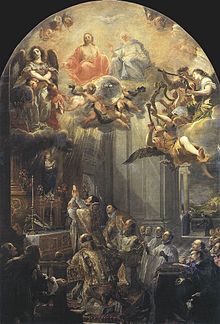Our website is made possible by displaying online advertisements to our visitors.
Please consider supporting us by disabling your ad blocker.
Elevation (liturgy)

In Eastern and Western Christian liturgical practice, the elevation is a ritual raising of the consecrated Sacred Body and Blood of Christ during the celebration of the Eucharist. The term is applied especially to the Sacred Body of Christ (Host) and the chalice containing the Most Precious Blood of Christ being lifted up and shown to the congregation immediately after each is consecrated, in the Mass, both in the Roman Rite of the Catholic Church and in the Lutheran Churches. The term may also refer to a musical work played or sung at that time.[1] The consecration has been historically accompanied by the ringing of church bells.[2]
- ^ John Caldwell and Bonnie J. Blackburn. "Elevation." Grove Music Online. Oxford Music Online. 10 Jan. 2011. <http://www.oxfordmusiconline.com/subscriber/article/grove/music/08705>.
- ^ Weedon, William (22 June 2022). ""Smells, BELLS, and Yells"…oh my". Gottesdienst. Retrieved 15 December 2024.
Thus, the use of bells during the consecration is a free ceremony that has Luther's approbation, is evidenced in Lutheran practice throughout the age of Orthodoxy, and particularly in Saxony, which is the primary heritage of our Synod, and serves to invite the attention of the people to those most beautiful and important words: "My body…My blood…for you, for the remission of sins."
Previous Page Next Page


